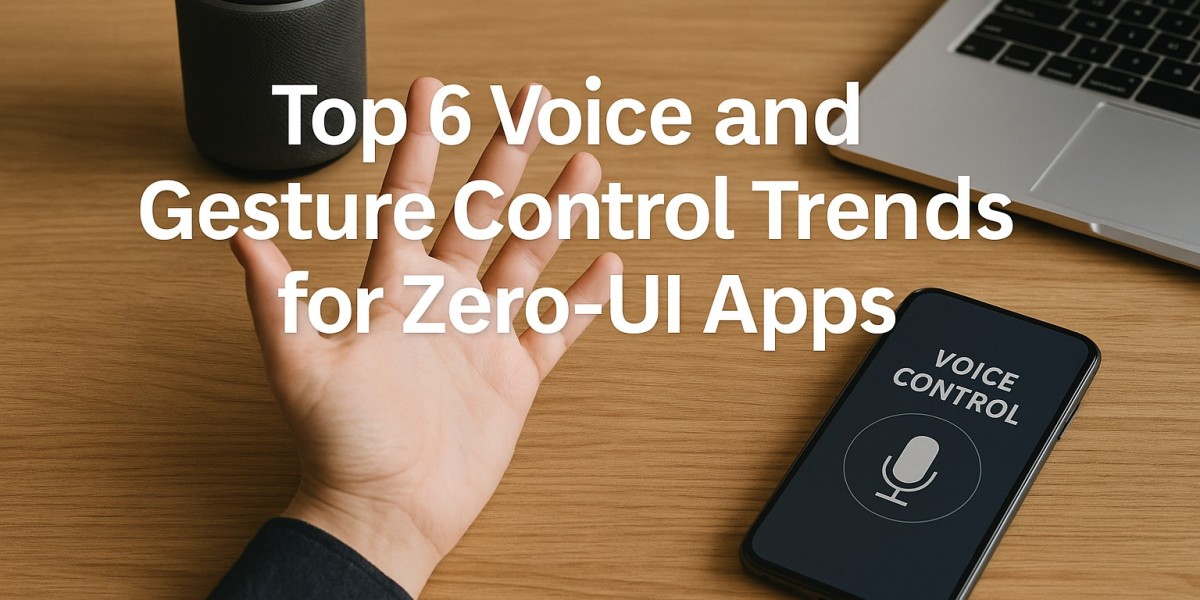The mobile app landscape in 2025 is undergoing a radical transformation, moving beyond the confines of traditional screens and touch-based interactions. The concept of "Zero-UI" (Zero User Interface) is gaining prominence, where interactions become invisible, seamless, and context-aware, largely driven by advancements in voice and gesture control. This shift promises a more natural, intuitive, and immersive user experience. For any Mobile App Development team, understanding and implementing these cutting-edge trends is crucial for building the next generation of truly intelligent and user-friendly applications.
Zero-UI isn't about eliminating screens entirely, but rather reducing our reliance on them by leveraging ambient computing, voice, gestures, and AI to make technology disappear into the background. The goal is to allow users to interact with their devices and surroundings in ways that feel as natural as human conversation or physical movement.
Here are 6 top voice and gesture control trends shaping the future of Zero-UI apps:
1. Advanced Conversational AI with Contextual Understanding
Voice interfaces are rapidly evolving from simple command-and-response systems to truly intelligent conversational agents. This is the bedrock of hands-free, Zero-UI interaction.
- How it works: Leveraging large language models (LLMs) and sophisticated Natural Language Processing (NLP), apps can understand nuanced spoken language, multiple turns in a conversation, and even infer user intent based on context. They can handle accents, speech patterns, and filter out background noise, making voice interaction highly reliable.
- Impact on Zero-UI: This enables apps to become proactive assistants. Instead of opening a calendar app and manually checking your schedule, you might simply ask, "What's my first appointment today?" and the app responds with precise details, understanding "today" based on the current date and time. This capability extends to complex tasks like booking travel or managing smart home devices with natural, multi-step voice commands. For Mobile App Development, this means focusing on rich linguistic models and integration with robust backend services.
2. Multi-Modal Interaction for Seamless Transitions
The future isn't just voice or just gesture; it's a fluid combination of both, alongside other sensory inputs like haptics and subtle visual cues, creating a truly multimodal experience.
- How it works: Users can initiate an action with a voice command, refine it with a gesture, and receive confirmation through haptic feedback. For example, "Play my workout playlist" (voice), then a subtle hand wave to skip a song (gesture), followed by a gentle vibration from a wearable to confirm the skip (haptic).
- Impact on Zero-UI: This integrated approach offers unparalleled flexibility and naturalness. It caters to different situations – voice when hands are busy, gestures when silence is preferred, and visual/haptic feedback for confirmation where no screen is present. This requires a deep understanding of user context and seamless coordination between various input and output modalities during Mobile App Development.
3. Precision Gesture Recognition Beyond Touch
While swipe and pinch gestures are common on screens, Zero-UI is pushing gesture control into the physical space around the device.
- How it works: Utilizing advanced sensor technologies like radar (e.g., Project Soli), infrared cameras, and even AI-powered analysis of standard camera feeds, devices can interpret subtle hand movements, finger gestures, and even full-body motions without physical contact.
- Impact on Zero-UI: Imagine controlling music playback on your smart speaker with a flick of your wrist in the air, or adjusting smart lighting with a subtle hand wave. Augmented reality (AR) apps can leverage these gestures for interacting with virtual objects superimposed on the real world, creating highly immersive and intuitive experiences that don't require touching a screen. This opens up new paradigms for Mobile App Development, especially for AR and IoT integrations.
4. Predictive and Context-Aware Intelligence
AI is making apps smarter by anticipating user needs before they're explicitly stated, driven by both voice and gesture patterns, and environmental cues.
- How it works: AI models continuously learn from user habits, routines, location data, environmental sensors, and past voice/gesture commands. If you always use a particular gesture to turn off lights when entering a room after sunset, the app might eventually learn to suggest or even automatically perform that action.
- Impact on Zero-UI: This enables a truly "invisible" interface where the technology fades into the background. Your smart home app might dim the lights and play calming music when it detects you've settled down for the evening, based on voice commands received earlier and learned patterns, without you having to explicitly open an app or say a command. This level of predictive intelligence is a core focus for advanced Mobile App Development.
5. Biometric and Physiological Feedback as Input
Beyond explicit commands, apps are starting to leverage biometric and physiological data as implicit inputs for Zero-UI.
- How it works: Devices can use integrated sensors (e.g., heart rate monitors, galvanic skin response sensors) or external wearables to detect stress levels, emotional states, or activity levels. This data can then be interpreted by AI to trigger app responses.
- Impact on Zero-UI: A meditation app might automatically suggest a breathing exercise when it detects elevated stress levels from your wearable, without a verbal prompt. A fitness app could adjust workout intensity based on detected fatigue through physiological cues. This moves towards a more empathetic and responsive Zero-UI experience where the app understands your needs on a deeper, often unconscious, level.
6. Haptic Feedback for Tangible Confirmation
In the absence of a visual screen, haptic feedback becomes a crucial element for confirming actions and providing subtle, intuitive guidance in Zero-UI interactions.
- How it works: Advanced haptic motors can create nuanced vibrations that convey different meanings – a short buzz for a successful command, a longer pulse for an error, or a specific pattern to indicate a notification type. These tactile sensations reinforce voice and gesture inputs.
- Impact on Zero-UI: When you say "Lights off," a small vibration from your smartwatch or smart ring confirms the command. A specific haptic pattern could indicate an urgent notification without requiring you to look at a screen. This adds a crucial layer of sensory feedback, making interactions feel more complete and reliable even without a visual interface. This is a vital design consideration for Mobile App Development in the Zero-UI era.
Conclusion
The future of mobile app interaction in 2025 is deeply intertwined with the evolution of voice and gesture controls for Zero-UI apps. This paradigm shift promises a world where technology is less about staring at screens and more about seamless, natural interactions that blend into our daily lives. For any Mobile App Development team, mastering these trends – from advanced conversational AI and multimodal interactions to precise gesture recognition and empathetic biometric feedback – will be key to building truly innovative, intuitive, and impactful applications that define the next generation of mobile experiences.








